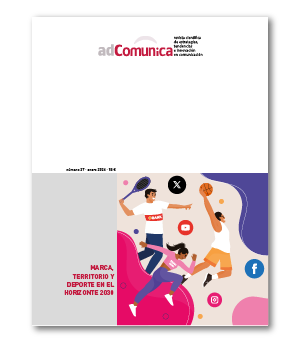Cuestionando el canon de los juegos de realidad alternativa a través de una reflexión sobre sus componentes fundacionales
##plugins.themes.bootstrap3.article.main##
Resum
Los juegos de realidad alternativa son una de las formas ludonarrativas más complejas y desconocidas de cuantas pueblan el ecosistema mediático, sobre la cual, una perspectiva de investigación parcial y desactualizada dificulta su adaptación a los nuevos tiempos. En base a un canon desusado se siguen articulando los acercamientos sobre los ARG veinte años más tarde, como entes ajenos a su Historia. El presente trabajo parte del cuestionamiento sobre los conceptos canónicos de los juegos de realidad alternativa, puppetmaster, rabbithole, the curtain y el acrónimo TINAG (this is not a game), y desemboca en la elaboración de un marco de análisis actualizado en el que han de tener presencia los ingredientes verdaderamente sustanciales del dispositivo, en contraste con formulaciones obsoletas del género. El paradigma cualitativo es la base de la metodología empleada, a partir de un relevamiento bibliográfico en busca de acercamientos al género en sentido ontológico y de disensiones y consensos sobre sus conceptos canónicos. Tras ello, ejecutamos un análisis de tipo descriptivo sobre los ingredientes básicos detectados para la formulación de una nueva receta sustancial y la articulación de un nuevo marco de análisis sobre los juegos de realidad alternativa.
Descàrregues
##plugins.themes.bootstrap3.article.details##
1. Política propuesta para Revistas que ofrecen Acceso Abierto
Los autores que publican en esta revista están de acuerdo con los siguientes términos:
- Los autores conservan los derechos de autor y garantizan a la revista el derecho de ser la primera publicación del trabajo al igual que licenciado bajo la licencia CC BY-SA, que permite a otros compartir el trabajo con un reconocimiento de la autoría del trabajo y la publicación inicial en esta revista.
- Los autores pueden establecer por separado acuerdos adicionales para la distribución no exclusiva de la versión de la obra publicada en la revista (por ejemplo, situarlo en un repositorio institucional o publicarlo en un libro), con un reconocimiento de su publicación inicial en esta revista.
Referències
Askwith, I. (2006). This Is Not (Just) An Advertisement. Understanding Alternate Reality Games. [Libro blanco]. MIT Convergence Culture Consortium. https://static1.squarespace.com/static/57240a6b4d088e4abb587a4d/t/5c4512c64fa51abcc0a85007/1548030666173/IvanAskwith_ThisIsNotJustAnAdvertisement.pdf
Bakioglu, B. (2017). The Coachella Disaster: How the Puppet Masters of Art of the H3ist Pulled a Victory from the Jaws of Defeat. En A. Garcia, G. Niemeyer (Eds.) Alternate Reality Games and the Cusp of Digital Gameplay. Bloomsbury.
Barlow, N. (2006). Types of ARG. En A. Martin, B. Thompson, T. Chatfield (Eds.) Alternate Reality Games white paper. IGDA ARG SIG. http://www.igda.org/arg/resources/IGDA-AlternateRealityGames-Whitepaper-2006.pdf
Caillois, R. (1986). Los Juegos y los Hombres. La máscara y el vértigo. Colección popular, fondo de cultura económica, México.
Checa, D., Bustillo, A. (2020) A review of immersive virtual reality serious games to enhance learning and training. Multimed Tools Appl 79, 5501–5527. https://doi.org/10.1007/s11042-019-08348-9
Dena, C. (19/08/2007). Why ARGs Aren’t Hoaxes. Christy Dena's Field Notes From Earth. http://www.christydena.com/online-essays/why-args-arent-hoaxes/
Diaz-Garcia, M. (2017). Juegos de Realidad Alternativa: un análisis geonarrativo y aumentado de Ingress. [Tesis de Doctorado. Universidad Complutense de Madrid]. https://eprints.ucm.es/id/eprint/42118/1/T38652.pdf
Evans, E. (2019). Understanding engagement in transmedia culture. Routledge.
Gabarri, M. (16/05/2018). Cuando Alicia cayó por la madriguera: Los juegos de realidad alternativa. Gamereport. https://gamereport.es/cuando-alicia-cayo-por-la-madriguera/
Hardy, J. (2021). Branded Content: The Fateful Merging of Media and Marketing. Routledge.
Hon, A. (14/11/2012). Are ARGs Dead? A Closer Look at a Common Refrain. ARGN. https://www.argn.com/2012/11/are_args_dead_a_closer_look_at_a_common_refrain/
Hook, A. (2017). The Game Did Not Take Place: performative play and relational art in Alternate Reality Games. En A. García, G. Niemeyer (Eds) Alternate Reality Games and the Cusp of Digital Gameplay. Bloomsbury.
Huizinga, J. (2007). Homo Ludens. Alianza Editorial/Emecé Publishers.
Iat20 (13/04/2021). Juegos de realidad alternativa: Una nueva dimensión lúdica. IAT. https://iat.es/blog/juegos-realidad-alternativa/
Jenkins, H. (2006). Convergence Culture: Where old and new media collide. Ediciones NYU Press.
Lee, E. (2002). This is not a Game, a discussion of the Creation of the AI Web Experience. GDC 2002 (Conferencia).
McGonigal, J. (Octubre de 2005). Alternate Reality Gaming experimental social structures for MMOs. Austin Game Conference http://www.avantgame.com/McGonigal_ARG_Austin%20Game%20ConferenceOct2005.pdf
McGonigal, J. (2011). Reality is Broken: Why games make us better and how they can change the world. Penguin Press.
McGonigal, J. (2020). Games. Jane McGonigal https://janemcgonigal.com/play-me/
Miguel Trula, E. (27/08/2017). Los antecesores de Manuel Bartual: seis famosos ARGs de Internet por si te quedaste con ganas de más. Magnet. https://magnet.xataka.com/en-diez-minutos/los-antecesores-de-manuel-bartual-seis-famosos-args-de-internet-por-si-te-quedaste-con-ganas-de-mas
Murray, J. (1997). Hamlet en la Holocubierta. Paidós.
Ortiz-Colón, A. M., Jordán, J., & Agredal, M. (2018). Gamificación en educación: una panorámica sobre el estado de la cuestión. Educação e pesquisa, 44.
Palmer, C., Petroski, A. (2016). Alternate Reality Games. Gamification for Performance. Boca Ratón: CRC Press.
Piñeiro-Otero, T., Costa-Sánchez, C. (2015). ARG (juegos de realidad alternativa). Contribuciones, limitaciones y potencialidades para la docencia universitaria.
Comunicar, Revista Científica de Educomunicación, nº 44, v. XXII.
Ruiz-García, D. (2020). Alternate Reality Games: Defining Gender Through an Updated Taxonomy. Cosecivi 2020. http://ceur-ws.org/Vol 2719/paper3.pdf
Ruiz-García, D. (2021). Juegos de realidad alternativa. Actualización y ampliación taxonómica de un género en estado gaseoso. En J. Alberich, D. Sánchez-Mesa (Eds.) Transmedialización y crowdsourcing en la cultura mediática contemporánea. Editorial Universidad de Granada.
Ruiz-García, D. (2022). Juegos de Realidad Alternativa: nuevas aproximaciones taxonómicas en camino a una redefinición del género. En G. Paredes Otero, I. López-Redondo (Coordinadores) Cultura audiovisual, periodismo y política: nuevos discursos y narrativas en la sociedad digital. Madrid: Ed. Dykinson.
Scolari, C. A. (2013). Narrativas Transmedia. Grupo Planeta.
Stacey, S. (10/11/2006). Undefinig ARG. Unfiction. http://www.unfiction.com/compendium/2006/11/10/undefining-arg/2/
Szulborski, D. (2005). This Is Not A Game. A Guide to Alternate Reality Gaming. New Fiction Publishing.
Szulborski, D. (2006). Through the rabbit hole. New Fiction Publishing.
Thompson, B. (27/04/2005). This Is Not A Game… ARGN. https://www.argn.com/2005/04/this_is_not_a_game/#more-13
Torrebejano, A. (2019). Juegos en vivo: Experiencias ARG, del Real Game a las Realidades Alternativas. El Cañonazo Transmedia. http://elcanonazo.com/juegos-vivo-experiencias-arg/
Van Berlo, Z. M., van Reijmersdal, E. A., & Eisend, M. (2021). The gamification of branded content: A meta-analysis of advergame effects. Journal of Advertising, 50(2), 179-196.


